|
Genus
Pheidole
(Subfamily Myrmicinae)

Biology
This is one of the most common groups of ants in Australia and they can
be encountered almost everywhere and at any time. Most species form nests
in the soil with a low mound of loose dirt around the entrance. These
mounds are often very active with many workers carrying soil from the
nest and foraging in the immediate vicinity. This can makes nests highly
visible. Other species nest under rocks and a few species are known to
occasionally nest arboreally. Some rainforest species nest in rotten
wood on the ground. Foraging is most common on the ground and large numbers
of workers can be found at highly desirable food sources such as honey
baits. In the tropics most foraging takes place during the late afternoon
and throughout the night while in cooler regions foraging occurs at all
times of the day and night. A wide range of food is taken as these ants
are general predators and scavengers. They will also feed on seeds and
can take large numbers very rapidly (Briese and Macauley 1981, Clayton-Greene
and Ashton 1990). The introduced species P. megacephala is a pest
common along the east and west coasts and in the Darwin region. It can
pose a serious threat to local invertebrate communities as it will severely
reduce or eliminate natives insects, especially other ants, with which
it comes in contact.
|top|
Distribution and Habitats
Pheidole is the second largest genus of ants in the world with
898 species and subspecies with an additional 3 species known from fossil
records. They are found world wide. About 53 species and subspecies
are known from Australia and these can be found throughout the continent
in all habitats (see map).
|top|
Identification Notes
The antennae are 12 segmented (including the scape) and have a 3 segmented
club (Figs 1, 5, 9). In side view the propodeum is depressed below the
level of the pronotum and forward section of the mesonotum, and these
two regions are connected by the steeply sloping rear section of the mesonotum
(Figs 2a, 4, 6, 8, 10). Workers with distinct majors and minors but without
intermediates (dimorphic) (compare Figs 3 and 4 with Figs 5 and 6, and
Figs 7 and 8 with Figs 9 and 10).
Pheidole
is most similar to Aphaenogaster
and Pheidologeton.
They can be separated from Aphaenogaster by the 3 segmented (Fig.
1a) rather than 4 segmented club and generally smaller body size (often
under 3.5 mm long), and from Pheidologeton by the 12 segmented
antennae with a 3 segmented club (antennae 11 segmented with a 2 segmented
club in Pheidologeton). Additionally, in Aphaenogaster
all workers are approximately the same size (they are monomorphic) while
in Pheidologeton there is continuous size variation between major
and minor workers (they are polymorphic).
|top|


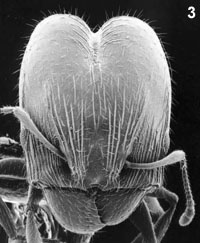
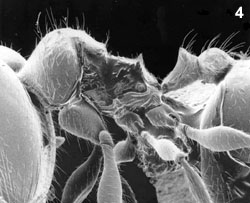




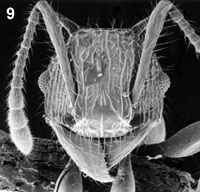

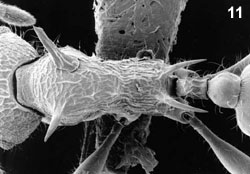

Many Pheidole species collect seeds as food for
their larvae. When empty, the seed coats are deposited outside the nest
near the entrance, often forming distinctive piles (nest entrance at centre-right).
(Photo by Steve Shattuck.)
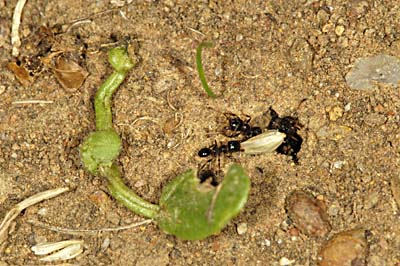
This worker is removing an empty grass seed from the nest
(dragging it backwards from the entrance). This refuse will be placed
on the nest's midden pile a few cm away. (Photo by Steve Shattuck.)

While Pheidole workers are well known for harvesting
seeds, they are also general predators and will take a wide range of food
items, such as this terrestrial amphipod (photo by Steve Shattuck).
Genus
Nomenclature
Pheidole Westwood
1841:87. Type species: Atta providens Sykes, by monotypy.
Taxonomic Catalogue
Go to the Taxonomic
Catalogue of Species.
|top|
Literature
Cited / Additional Reading
Briese, D. T., Macauley,
B. J. 1981. Food collection within an ant community in semi-arid
Australia, with special reference to seed harvesters. Aust. J. Ecol.
6:1-19.
Clayton-Greene, K. A., Ashton, D. H. 1990. The dynamics of Callitris
columellaris/Eucalyptus albens communities along the Snowy
River and its tributaries in South-eastern Australia. Aust. J. Bot.
38:403-432.
Westwood, J.O. 1841. Observations on the genus Typhlopone,
with descriptions of several exotic species of ants. Ann. Mag. Nat.
Hist. (1)6: 81-89.
|top|
|

